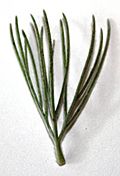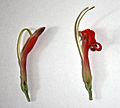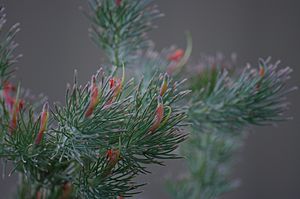Woolly bush facts for kids
Quick facts for kids Woolly bush |
|
|---|---|
 |
|
| Scientific classification | |
| Genus: |
Adenanthos
|
| Species: |
sericeus
|
| Subspecies | |
|
A. sericeus subsp. sericeus |
|
The Adenanthos sericeus, also known as the woolly bush, is a cool plant that grows as a shrub in Western Australia. You can find it along the south coast. It has small, bright red flowers that are a bit hidden, and its leaves are super soft, divided into many tiny parts, and feel hairy.
Contents
What Does the Woolly Bush Look Like?
The woolly bush usually grows as an upright, spreading shrub. Sometimes, it can even become a small tree up to 5 meters (16 feet) tall! Its branches stand up straight and are covered in short hairs when they are young. These hairs disappear as the plant gets older. The leaves can be up to 40 millimeters (1.6 inches) long. They divide into many tiny, narrow parts, like thin threads, which are less than 0.5 millimeters (0.02 inches) wide. Each leaf can have anywhere from 5 to 50 of these tiny segments.
The flowers are red and grow alone or in small groups. They are often hidden among the leaves at the ends of the branches. Like many other plants in the Proteaceae family, each flower has a tube-shaped outer part called a perianth made of four joined sections. Inside is a single pistil, which is the female part of the flower. The tip of the pistil, called the stigma, is first trapped inside the flower's tip. When the flower opens (this is called anthesis), the stigma pops out. In the woolly bush, the perianth is bright red, about 28 millimeters (1.1 inches) long, and hairy on the outside but smooth inside. The style (the stalk of the pistil) is about 40 millimeters (1.6 inches) long. Since it's much longer than the perianth, it bends sharply until the stigma is released, then it springs straight up. The fruit is a small, oval-shaped seed pod about 5 millimeters (0.2 inches) long.
How We Name and Classify Plants
Who Discovered and Named the Woolly Bush?
The woolly bush was first described by a scientist named Jacques Labillardière in his book Novae Hollandiae Plantarum Specimen in 1805. He gave it the name Adenanthos sericea. The name sericeus comes from a Latin word meaning "silky," which describes the plant's very soft leaves.
For a long time, people thought Labillardière himself collected the first samples of this plant. This made sense because A. sericeus grows in a place called Esperance Bay, where Labillardière collected plants in December 1792. However, some plants he described don't grow in the places he visited. This made another scientist, Ernest Charles Nelson, look closer at the original plant samples. He found clues that Labillardière might not have collected them. For example, the samples were from a different herbarium (plant collection) and belonged to a type of woolly bush found near King George Sound, not Esperance Bay.
Nelson believed that another explorer, Jean Baptiste Leschenault de la Tour, who visited King George Sound in 1803, might have collected the samples. This idea is now accepted by many scientists.
How the Woolly Bush Fits into the Plant Family Tree
In 1870, George Bentham organized the Adenanthos group of plants. He put A. sericeus into a section called Adenanthos sect. Adenanthos because its flower tube is straight. This classification is still used today.
Over time, other plants were mistakenly grouped with A. sericeus, like A. oreophila and A. cygnorum. But in the 1970s, Ernest Charles Nelson studied Adenanthos again. He realized that the woolly bush found on Kangaroo Island in South Australia was different enough to be its own species. He named it A. macropodianus in 1978. He also made sure that A. oreophila and A. cygnorum were recognized as separate species.
Later, the rules for naming plants changed, and the name sericea became sericeus to match the gender of the genus name.
Here's a simplified look at where the woolly bush fits in its plant family:
- Adenanthos (The main group)
- A. sect. Eurylaema (4 species)
- A. sect. Adenanthos (Many species, including...)
- A. sericeus (Our woolly bush!)
- A. sericeus subsp. sericeus
- A. sericeus subsp. sphalma
- A. × cunninghamii (A hybrid plant)
- A. oreophilus
- A. cygnorum (2 subspecies)
- ...and many other Adenanthos species!
- A. sericeus (Our woolly bush!)
Different Types of Woolly Bush
There are two main types, or subspecies, of the woolly bush:
- A. sericeus subsp. sericeus: This type grows mostly around King George Sound. Its leaves are usually longer than 30 millimeters (1.2 inches) and have many tiny segments, often between 11 and 35, but sometimes up to 50!
- A. sericeus subsp. sphalma: This type is found at Cape Le Grand. Its leaves are smaller and usually have about 6 segments, rarely more than 12. The name sphalma comes from a Latin word meaning "mistake," because scientists initially mixed up which type was the original one.
There's also a plant called Adenanthos × cunninghamii which is a mix, or hybrid, between A. sericeus subsp. sericeus and another plant called A. cuneatus. You can find it in places like Torndirrup National Park. You can tell it apart from the regular woolly bush because its flowers are not as bright, and its leaves have thicker segments. Also, like A. cuneatus, its new growth is red.
Popular Names for the Woolly Bush
People call A. sericeus by several names, like Woollybush. This name is used for all Adenanthos plants with deeply divided leaves. Other names include Coastal Woollybush, Tall Woollybush, and Albany Woollybush. However, "Albany Woollybush" can be confusing because it's also used for the hybrid plant, A. × cunninghamii.
In the cut flower business, where its silvery leaves are popular, it's sometimes called Smoke Bush or Australian Smoke Bush.
In plant nurseries, it's sold as Silver Streak because it's a great plant for hedges in gardens.
Where Does the Woolly Bush Grow?
The woolly bush grows in a few separate areas along about 500 kilometers (300 miles) of the south coast of Western Australia.
The A. sericeus subsp. sericeus type is mostly found around King George Sound. It can grow very close to the sea. Then there's a big gap of over 300 kilometers (200 miles) before you find the A. sericeus subsp. sphalma type at Cape Le Grand. Another group of A. sericeus subsp. sphalma grows even further east at Cape Arid.
Both types of woolly bush only grow in sandy soils that come from weathered granite. This means you often find them near granite hills. Even though its range is limited, it's very common in those areas and often the most dominant plant. The A. sericeus subsp. sphalma type often grows alongside other plants like Nuytsia floribunda, Kunzea baxteri, and Xanthorrhoea species.
Life Cycle and Challenges
Both types of woolly bush flower all year round, but A. sericeus subsp. sphalma flowers most from August to December.
Unfortunately, the woolly bush can get sick from a plant disease called Phytophthora cinnamomi dieback.
Growing Woolly Bush in Your Garden
Even though its flowers are not very showy, the woolly bush is a beautiful plant for gardens because of its colorful and soft leaves. It can handle salty winds very well, making it a great plant to use as a screen in coastal areas. In the Albany area, people sometimes use branches or even whole potted woolly bushes as Christmas trees. This is because young plants look a bit like small pine trees but feel silky.
You can grow new woolly bushes from cuttings (small pieces of the plant). They root easily, but you need to be careful not to spray too much water on the leaves, or they might rot. This plant needs soil that drains water very well and doesn't do well in very humid places. It doesn't have a special woody base that helps it regrow after heavy pruning, so it's best to only trim it lightly.
Some special types of woolly bush have been created for gardens, including two that were developed in Israel.
The silvery leaves of the woolly bush are also used in the cut flower industry. They last a very long time in a vase, sometimes up to 30 days!





